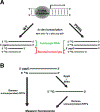A T7 RNA Polymerase Mutant Enhances the Yield of 5'-Thienoguanosine-Initiated RNAs
- PMID: 29115013
- PMCID: PMC6047071
- DOI: 10.1002/cbic.201700538
A T7 RNA Polymerase Mutant Enhances the Yield of 5'-Thienoguanosine-Initiated RNAs
Abstract
Spectroscopic methods, which are used to establish RNA structure-function relationships, require strategies for post-synthetic, site-specific incorporation of chemical probes into target RNAs. For RNAs larger than 50 nt, the enzymatic incorporation of a nucleoside or nucleotide monophosphate guanosine analogue (G analogue) at their 5'-end is routinely achieved by T7 RNA polymerase (T7RNAP)-mediated in vitro transcription (IVT) of the appropriate DNA template containing a GTP-initiating class III Φ6.5 promoter. However, when high G analogue:GTP ratios are used to bias G analogue incorporation at the 5'-end, RNA yield is compromised. Here, we show that the use of a T7RNAP P266L mutant in IVT with 10:1 thienoguanosine (th G):GTP increased the percent incorporation and yield of 5'-th G-initiated precursor tRNA for a net ≈threefold gain compared to IVT with wild-type T7RNAP. We also demonstrated that a one-pot multienzyme approach, consisting of transcription by T7RNAP P266L and post-transcriptional cleanup by polyphosphatase and an exonuclease, led to essentially near-homogeneous 5'-th G-modified transcripts. This approach should be of broad utility in preparing 5'-modified RNAs.
Keywords: RNA; T7 RNA polymerase; fluorescent probes; in vitro transcription; thienoguanosine.
© 2018 Wiley-VCH Verlag GmbH & Co. KGaA, Weinheim.
Figures




Similar articles
-
An RNase P-Based Assay for Accurate Determination of the 5'-Deoxy-5'-azidoguanosine-Modified Fraction of in Vitro-Transcribed RNAs.Chembiochem. 2018 Nov 16;19(22):2353-2359. doi: 10.1002/cbic.201800447. Epub 2018 Oct 24. Chembiochem. 2018. PMID: 30194891 Free PMC article.
-
Polymerase-Mediated Site-Specific Incorporation of a Synthetic Fluorescent Isomorphic G Surrogate into RNA.Angew Chem Int Ed Engl. 2017 Jan 24;56(5):1303-1307. doi: 10.1002/anie.201609327. Epub 2016 Dec 21. Angew Chem Int Ed Engl. 2017. PMID: 28000329 Free PMC article.
-
Relaxed rotational and scrunching changes in P266L mutant of T7 RNA polymerase reduce short abortive RNAs while delaying transition into elongation.PLoS One. 2014 Mar 20;9(3):e91859. doi: 10.1371/journal.pone.0091859. eCollection 2014. PLoS One. 2014. PMID: 24651161 Free PMC article.
-
The highly efficient T7 RNA polymerase: A wonder macromolecule in biological realm.Int J Biol Macromol. 2018 Oct 15;118(Pt A):49-56. doi: 10.1016/j.ijbiomac.2018.05.198. Epub 2018 May 27. Int J Biol Macromol. 2018. PMID: 29847782 Review.
-
Structure and function in promoter escape by T7 RNA polymerase.Prog Nucleic Acid Res Mol Biol. 2005;80:323-47. doi: 10.1016/S0079-6603(05)80008-X. Prog Nucleic Acid Res Mol Biol. 2005. PMID: 16164978 Review. No abstract available.
Cited by
-
Purification, reconstitution, and mass analysis of archaeal RNase P, a multisubunit ribonucleoprotein enzyme.Methods Enzymol. 2021;659:71-103. doi: 10.1016/bs.mie.2021.07.006. Epub 2021 Sep 25. Methods Enzymol. 2021. PMID: 34752299 Free PMC article.
-
Bifacial PNAs Destabilize MALAT1 by 3' A-Tail Displacement from the U-Rich Internal Loop.ACS Chem Biol. 2021 Aug 20;16(8):1600-1609. doi: 10.1021/acschembio.1c00575. Epub 2021 Aug 12. ACS Chem Biol. 2021. PMID: 34382766 Free PMC article.
-
A New Variant of Emissive RNA Alphabets.Chemistry. 2022 Mar 1;28(13):e202104472. doi: 10.1002/chem.202104472. Epub 2022 Feb 2. Chemistry. 2022. PMID: 35018663 Free PMC article.
-
Isomorphic Fluorescent Nucleosides.Acc Chem Res. 2024 May 7;57(9):1325-1335. doi: 10.1021/acs.accounts.4c00042. Epub 2024 Apr 13. Acc Chem Res. 2024. PMID: 38613490 Free PMC article.
-
Synthetic bPNAs as allosteric triggers of hammerhead ribozyme catalysis.Methods Enzymol. 2019;623:151-175. doi: 10.1016/bs.mie.2019.04.028. Epub 2019 May 22. Methods Enzymol. 2019. PMID: 31239045 Free PMC article.
References
-
- Alexander S, Devaraj N, Biochemistry 2017, 56, 5185–5193. - PubMed
-
- Paredes E, Evans M, Das SR, Methods 2011, 54, 251–259. - PubMed
-
- a) Lee GH, Lim HK, Jung W, Hah SS, Bull. Korean Chem. Soc 2012, 33, 3861–3863;
- b) Skipsey M, Hack G, Hoope TA, Shankey MC, Conway LP, Schroder M, Hodgson DRW, Nucleos. Nucleot. Nucl 2013, 32, 670–681; - PMC - PubMed
- c) Zhang L, Sun L, Cui Z, Gottlieb RL, Zhang B, Bioconjug. Chem. 2001, 12, 939–948; - PubMed
- d) Williamson D, Cann MJ, Hodgson DRW, Chem Commun. 2007, 47, 5096–5098. - PubMed
Publication types
MeSH terms
Substances
Grants and funding
LinkOut - more resources
Full Text Sources
Other Literature Sources
Research Materials

